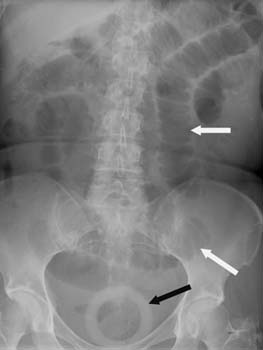Summary
Differentials
Common
- Gastritis
- Gastro-oesophageal reflux disease
- Peptic ulcer disease
- Viral gastroenteritis
- Food poisoning
- Chronic post-viral nausea and vomiting
- Migraine
- Motion sickness
- Benign paroxysmal positional vertigo
- Stroke (embolic/ischaemic/haemorrhagic)
- Hypercalcaemia
- Hypothyroidism
- Gastric outlet obstruction
- Small bowel obstruction
- Large bowel obstruction
- Choledocholithiasis
- Acute cholecystitis
- Post-gastrointestinal surgery
- Severe constipation
- Irritable bowel syndrome (IBS)
- Cyclic vomiting syndrome (CVS)
- Gastric dysrhythmias
- Gastroparesis
- Bacterial peritonitis
- Anorexia nervosa
- Bulimia nervosa
- Pregnancy
- Drug-induced
- Nephrolithiasis
- Uraemia
- Idiopathic functional dyspepsia or post-prandial distress syndrome
Uncommon
- Acute coronary syndrome
- Postural orthostatic tachycardia syndrome
- Meniere's disease
- Vestibular schwannoma
- Traumatic brain injury
- Meningitis
- Brain abscess
- Focal impaired awareness seizures
- Central nervous system tumours
- Primary adrenal insufficiency (acute or chronic)
- Hyperthyroidism
- Hypopituitarism
- Heat stroke
- Acute pancreatitis
- Diabetic ketoacidosis
- Bariatric surgery sequelae
- Primary pseudo-obstruction
- Secondary pseudo-obstruction
- Abdominal abscess
- Carcinomatous peritonitis
- Stomach cancer
- Ovarian cancer
- Renal cancer
- Small cell lung cancer
- Pancreatic cancer
- Chronic mesenteric ischaemia
- Cannabinoid hyperemesis
- Chronic nausea and vomiting after antibiotics or anaesthetics
Contributors
Authors
Thomas L Abell, MD
Professor of Medicine
Arthur M. Schoen, MD, Chair in Gastroenterology
Gastrointestinal Motility Clinic
Louisville
KY
Disclosures
TLA receives funding from the National Institutes of Health (NIH) Gastroparesis Clinical Research Consortium (GpCRC), and the NIH Gastric Dysrhythmias. He is an investigator for Cindome, Vanda, Neurogastrx, and Processa; a consultant for Nuvaira, Takeda, Medtronic, and Enterra Medical; a speaker for Takeda and Enterra Medical; a reviewer for UpToDate; the Gastric Electrical Stimulation editor for Neuromodulation, Wikistim; and the founder of ADEPT-GI which has intellectual property for autonomic/enteric and bioelectric diagnosis and therapies. TLA is an author of a number of references cited in this topic.
Prateek Mathur, MD
University of Louisville
Division of Gastroenterology, Hepatology, and Nutrition, Department of Medicine
Louisville
KY
Disclosures
PM declares that he has no competing interests.
Acknowledgements
Professor Thomas L Abell and Dr Prateek Mathur would like to gratefully acknowledge Dr Kenneth L Koch, a previous contributor to this topic.
Disclosures
KLK is a consultant for GlaxoSmithKline and a shareholder in 3 CPM Company. He is an author of a number of references cited in this topic.
Peer reviewers
James Neuberger, BM, BCh
Consultant Physician
Liver Unit
Queen Elizabeth Hospital
Birmingham
UK
Disclosures
JN declares that he has no competing interests.
Daniel Leffler, MD, MS
Instructor in Medicine
Harvard Medical School
Director of Clinical Research
The Celiac Center
Beth Israel Deaconess Medical Center
Boston
MA
Disclosures
DL declares that he has no competing interests.
Ned Snyder, MD, FACP
Professor of Medicine
Chief of Clinical Gastroenterology and Hepatology
University of Texas Medical Branch
Galveston
TX
Disclosures
NS declares that he has no competing interests.
Peer reviewer acknowledgements
BMJ Best Practice topics are updated on a rolling basis in line with developments in evidence and guidance. The peer reviewers listed here have reviewed the content at least once during the history of the topic.
Disclosures
Peer reviewer affiliations and disclosures pertain to the time of the review.
References
Key articles
Quigley EM, Hasler WL, Parkman HP. AGA technical review on nausea and vomiting. Gastroenterology. 2001 Jan;120(1):263-86.Full text Abstract
American College of Gastroenterology. Clinical guideline: gastroparesis. Aug 2022 [internet publication].Full text
Reference articles
A full list of sources referenced in this topic is available to users with access to all of BMJ Best Practice.

Guidelines
- The royal children’s hospital, Melbourne: clinical practice guideline: vomiting
- American Gastroenterological Association clinical practice update on diagnosis and management of cyclic vomiting syndrome: commentary
More GuidelinesCalculators
Glomerular Filtration Rate Estimate by the IDMS-Traceable MDRD Study Equation
More CalculatorsVideos
Diagnostic lumbar puncture in adults: animated demonstration
More videosLog in or subscribe to access all of BMJ Best Practice
Use of this content is subject to our disclaimer